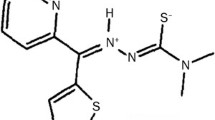We performed an in vivo comparative study of activity of three substances of the nitrosourea group produced in Russia. All substances demonstrated high antitumor activity against various solid and leukemic tumors. Aranosa significantly enhanced life duration in mice with leukemia (by 65-194%) and inhibited the growth of solid tumors (by 49-99.6%). Lisomustine and ormustine showed higher activity than aranose. Single administration of lisomustine increased life span of mice (by 22-114%) and resulted in cure of all animals in four models: lymphoblastic leukemia L-1210, lymphocytic leukemia P-388, Lewis lung carcinoma, and cervical cancer RShM-5. After ormustine treatment, full recovery was observed only in groups with lymphocytic leukemia P-388 and cervical cancer RShM-5. These findings attest to higher activity of lisomustine in the studied models.
Similar content being viewed by others
References
Baryshnikova MA, Al’bassit B, Saprykina NS, Levit GL, Matveeva TV, Krasnov VP. Antitumor activity of a new compound from the class of nitrosoalkylurea. Ross. Bioter. Zh. 2013;12(1):8-8а. Russian.
Bol’shakov OP, Neznanov NG, Babakhanyan RV. Didactic and ethical aspects of experiments on biomodels and laboratory animals. Kachestvennaya Klin. Praktika. 2002;(1):24-28. Russian.
Grischenko NV, Albassit B, Baryshnikova MA, Lantsova AV, Polozkova AP, Oborotova NA, Krasnov VP, Baryshnikov AYu. Cytotoxic effect of anticancer drug formulations belonging to nitrosourea subclass. Ross. Bioter. Zh. 2014;13(1):49-53. Russian.
Il’in VP. Methodological peculiarities of application of the Student t-test in biomedical studies. Acta Biomedica Scientifica. 2011;(5):160-161. Russian,
Lantsova AV, Sanarova EV, Oborotova NA. Antineoplastic preparations derivative of nitrosoalkylurea for treatment of cancer neoplastic of different genesis. Biofarm. Zh. 2014;6(5):38-51. Russian.
Saprykina NS, Borisova LM, Kiseleva MP, Krasnov VP, Levit GL, Musiyak VV, Baryshnikova MA, Bukhman VM, Shprakh ZS. Antitumor activity of ormustine against transplantable solid murine tumors. Part I. Ross. Bioter. Zh. 2017;16(4):55-60. Russian.
Saprykina NS, Borisova LM, Kiseleva MP, Smirnova ZS, Krasnov VP, Levit GL, Musiyak VV, Baryshnikova MA, Bukhman VM, Shprakh ZS, Davydov MM. Antitumor activity of Ormustine against transplanted leukemia in mice. Ross. Bioter. Zh. 2016;15(2):24-31. Russian.
Agarwal S, Tyagi G, Chadha D, Mehrotra R. Structural-conformational aspects of tRNA complexation with chloroethyl nitrosourea derivatives: A molecular modeling and spectroscopic investigation. J. Photochem. Photobiol. B. 2017;166:1-11.
Carrillo JA, Munoz CA. Alternative chemotherapeutic agents: nitrosoureas, cisplatin, irinotecan. Neurosurg. Clin. N. Am. 2012;23(2):297-306.
Gudtsova KV, Kukushkina GV, Gorbacheva LB, Peretolchina NM, Sof’ina ZP. Antitumor activity and mechanism of action of a new alkylnitrosourea. Pharm. Chem. J. 1992;25(9):597-603.
Levit GL, Radina LB, Krasnov VP, Gopko VF, Nikiforova NV, Peretolchina NM. Nω-alkylnitrosocarbamoyl-α,ω-diaminogarboxy lic acids. 3. Synthesis and antitumor activity of Nε-nitroso-Nε-[N′-(2-chloroethyl)carbamoyl]-L-lysine and Nε-[N′-(2-chloroethyl)-N′-nitroso-carbamoyl]-L-lysine. Pharm. Chem. J. 1996;30(5):306-309.
Nikolaeva L, Oborotova N, Bunyatyan N, Zhang X, Sanarova E, Lantsova A, Orlova O, Polozkova A. The development of a parenteral pharmaceutical formulation of a new class of compounds of nitrosourea. Pharmaceuticals (Basel). 2016;9(4). pii: E68.
Nikolova T, Roos WP, Krämer OH, Strik HM, Kaina B. Chloroethylating nitrosoureas in cancer therapy: DNA damage, repairand cell death signaling. Biochim. Biophys. Acta. 2017;1868(1):29-39.
Sun G, Zhang N, Zhao L, Fan T, Zhang S, Zhong R. Synthesis and antitumor activity evaluation of a novel combi-nitrosourea prodrug: Designed to release a DNA cross-linking agent and an inhibitor of O(6)-alkylguanine-DNA alkyltransferase. Bioorg. Med. Chem. 2016;24(9):2097-2107.
Yadav A, Singh VK. The antineoplastic behaviour of nitrosoureas: an ab initio study. J. Mol. Struct. (Theochem). 1997; 389(1-2):191-198. doi:https://doi.org/10.1016/S0166-1280(96)04638-6.
Author information
Authors and Affiliations
Corresponding author
Additional information
Translated from Byulleten’ Eksperimental’noi Biologii i Meditsiny, Vol. 166, No. 10, pp. 446-450, October, 2018
Rights and permissions
About this article
Cite this article
Bunyatyan, N.D., Oborotova, N.A., Nikolaeva, L.L. et al. Comparative Analysis of Bioactivity of the Russian-Made Antitumor Substances of the Nitrosourea Group. Bull Exp Biol Med 166, 456–460 (2019). https://doi.org/10.1007/s10517-019-04371-w
Received:
Published:
Issue Date:
DOI: https://doi.org/10.1007/s10517-019-04371-w




